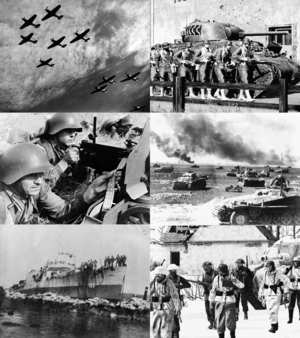Great Ottonian War
| Great Ottonian War | |||||||
|---|---|---|---|---|---|---|---|
 {faction} aircraft flying towards {target}; North Ottonian troops behind a {Not!Sherman} tank in {location}, Ostrozavan troops man a Zubrov machine gun during the Battle of {place}; Destroyed armor on the inter-Ottonian border in the aftermath of the Battle of {place2}; {denonym} {ship name} beached during the landings at {place}; South Ottonian and Sudmarker troops marching towards {place3} during the winter of 1938. | |||||||
| |||||||
| Belligerents | |||||||
|
| ||||||
The Great Ottonian War was a military conflict in Northwestern Belisaria, centered on the conflict between republican North Ottonia and monarchist South Ottonia. It was in many ways a direct continuation of the Ottonian Civil War that had divided Ottonia into two rival states.
The war lasted from 1935 to 1943 and involved direct hostilities between the two Ottonian states, as well as interventions by Ghantish, Yisraeli, and Ostrozavan forces. The conflict resulted in widespread economic devastation for Ottonia as a whole, as well as leading to significant territorial gains for North Ottonia.
Background
When the Ottonian Civil War concluded with the 1922 Armistice & Partition of Ottonia, setting borders to the rival United Kingdom of Ottonia and Republic of Ottonia, it represented a state of affairs neither side was pleased with. The failure by either side to achieve total victory, and the resulting lack of legitimacy for either the southern monarchist government nor the northern republican government left both sides intent on completing the destruction of their rival and the unification of Ottonia under their own banner.
Over the ensuing decade, both sides rearmed and rebuilt their armed forces, drawing up plans for the inevitable confrontation. While North Ottonia's military planners largely assumed a one-on-one confrontation, South Ottonia's rulers, Rudulf I and Anna I, reached out to Ghant for aid in their mission of reunifying the realm. Due to the influence of Anna's aunt Edaalya, the wife of Emperor Nathan III of Ghant, they found a ready audience. A plan was drawn up to destroy the republican holdout in the north, utilizing simultaneous invasions along the front between the United Kingdom and the Republic, assisted by a seaborne invasion of the Jormundea region of North Ottonia by Ghantish forces, supported by the Ghantish Imperial Navy.
When it became clear that the forces of South Ottonia were planning to strike in late 1934, North Ottonian Premier Rudulfus Walden put out a call for aid to several republican and anti-monarchical states around Norumbia and Belisaria, including Wazheganon, Talahara, Ostrozava, and even to far-off Zacapican. Ultimately, the request would not bear fruit quickly enough.
The War
The First Strike (1935)
A coordinated invasion of Jormundea by Ghantish forces and Eona by Royalist forces in April of 1935 caught the Republic's forces off-balance, due to a mistaken belief that the South was still at least six months away from being prepared for an invasion. Abruptly fighting on two fronts, Northern forces were ineffective in blunting the South's advance to Ottonia. This also led to the death of many high-ranking North Ottonian government officials, including the Premier himself, captured by Royalist forces as they attempted to evacuate the old imperial city.
With the North nearly decapitated, it seemed as if the South might accomplish its goals of reunifying the whole of Ottonia under its yellow banner. However, while Royalist and Ghantish advances in the northwest were largely successful, attempts at establishing additional beachheads further east were repelled, and attempts to push north through the Bluwaald Mountains from Staalmark resulted in Royalist forces absorbing hideous losses in ambushes by Republican forces led by Otto Kraag, backed up by irregulars drawn from the southern Bluwaald populace. However, following a disastrous first month, Northern forces began to rally; first, an attempt to seize Dunnmaar by Ghantish forces was foiled by the Federal Navy at the Battle of Blancaster.
Still, despite stiffening resistance, Ghantish and South Ottonian forces had taken much of the Ardryk Peninsula and were rolling through much of Eona by the winter of 1935/1936. As hostilities slowed with the onset of the cold weather, however, irregular forces were organizing in the invaders' rear. As Ghantish and South Ottonian troops settled in to occupy the areas they'd taken, they were unaware that they would soon be faced with a bloody winter.